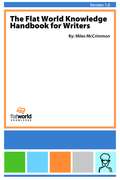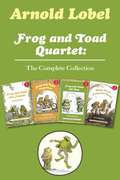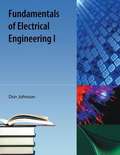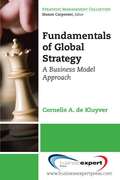- Table View
- List View
FHSST: Grade 11 Physical Science
by Rory Adams Heather Williams Mark Horner Sarah BlythGrade 11 physical science textbook for South Africa
FHSST: Grade 12 Maths
by Rory Adams Mark Horner Heather Williams Sarah Blyth Wendy WilliamsGrade 12 maths textbook for South Africa
FHSST: Grade 11 Maths
by Rory Adams Sarah Blyth Heather WilliamsGrade 11 maths textbook for South Africa
FHSST: Grade 12 Physical Science
by Rory Adams Heather Williams Mark Horner Kosma Von MaltitzGrade 12 physical science textbook
FHSST: Grade 10 Physical Science
by Rory Adams Mark Horner Sarah Blyth Heather Williams Wendy WilliamsGrade 10 physical science textbook
Financial Accounting
by Joe Ben Hoyle C. J. SkenderThis book is suitable for an undergraduate or MBA level Financial Accounting course. If authorship matters (and we believe it is everything) then this book is destined to be a classic. There are no two better authors than these. Joe Ben Hoyle is co-author of two current market-leading advanced accounting textbooks with McGraw-Hill. He and and co-author CJ Skender are nationally recognized as master teachers. Both have won numerous teaching awards, and both were recently recognized by BusinessWeek as top undergraduate professors. The authors bring their collective teaching wisdom to bear in this book not by changing "the message"(financial accounting content), but by changing "the messenger" (the way the content is presented). The approach centers around utilizing the Socratic method, or simply put, asking and answering questions. The reason that this approach continues to be glorified after thousands of years is simple - it engages students and stresses understanding over memorization. So this text covers standard topics in a standard sequence, but does so through asking a carefully constructed series of questions along with their individual answers.
A First Course in Electrical and Computer Engineering
by Louis ScharfElectrical and computer engineering textbook
The Flat World Knowledge Handbook for Writers
by Miles MccrimmonAre you teaching freshman level students? Is this one of the first college level courses your students have ever taken? Probably. That is why this English Handbook is different (and we think better). Miles McCrimmon's, The Flat World Knowledge Handbook for Writers is based on the understanding that writing is at the center of the college experience, not just something students do on their way to "higher-level" coursework. The Flat World Knowledge Handbook for Writers supports the goal of acculturating entering students to the demands of college-level thinking and writing, whether that goal is being met through coursework in Composition, Student Development, or some combination of the two.
Focusing on Organizational Change
by William Q. Judge Jr.Never before have strategic leaders been confronted with so much overwhelming change. The traditional approach taken by the leader or leaders is to direct or control the organization's reaction on a monthly, weekly, or even daily basis. This approach is stressful and overwhelming for executive leaders, makes middle managers feel torn between honoring their senior leaders and listening to the demands of frontline employees, and is alienating for frontline employees. This approach is hardly a prescription for the pursuit of excellence, and does not enable the organization to be sufficiently agile or nimble to cope with the "white water" conditions in which the organization typically finds itself. This book offers an alternative to the traditional approach by focusing on building the change capacity of the entire organization in anticipation of future pressures to change. An organization's capacity for change is an eight-dimensional dynamic capability of an organization or organizational unit to successfully adapt to the changing organization-environment interface. In change-capable organizations, the strategic leader's role is more of an architect or designer of the organization in anticipation of oncoming change, rather than a commander or controller reacting to change. This approach unleashes the organization's creative potential while maintaining accountability, clarifies the roles of each and every employee in the change process while enhancing organizational flexibility, aligns organizational systems to facilitate change, and builds the organization's leadership pipeline for the future. Based on systematic research of more than 5,000 respondents working within more than 200 organization or organizational units conducted during the previous decade, this book offers a clear and proven method for diagnosing your organizational change capacity. Building on my previous consulting experience and anecdotal evidence, you will also learn how to enhance your organization's change capacity. While building organizational change capacity is not fast or easy, it is essential for effective leadership and organizational survival in the 21st century. This book provides guidance on how to do that essential work in the new millennium.
Foundations of Business Law and the Legal Environment
by Don Mayer Daniel M. Warner George J. Siedel Jethro K. LiebermanMayer, Warner, Siedel and Lieberman's Foundations of Business Law and the Legal Environment is an up-to-date textbook with comprehensive coverage of legal and regulatory issues for your introductory Legal Environment or Business Law course. The text is organized to permit instructors to tailor the materials to their particular approach. The authors take special care to engage students by relating law to everyday events with which they are already familiar with their clear, concise and readable style. Business Law and the Legal Environment provides students with context and essential concepts across a broad range of legal issues with which managers and business executives must grapple. The text provides the vocabulary and legal savvy necessary for business people to talk in an educated way to their customers, employees, suppliers, government officials -- and to their own lawyers. With Foundations of Business Law and the Legal Environment, the authors have created a text that not only has both case summaries and excerpted cases, but one that you can easily customize by deleting chapters, reordering the content, adding your own material, and even editing at the line level with Flat World's easy-to-use MIYO (Make It Your Own) Platform.
Frog and Toad Quartet: I Can Read Level 2: Frog and Toad are Friends, Frog and Toad Together, Frog and Toad All Year, Days with Frog and Toad (I Can Read Level 2)
by Arnold LobelCelebrate the power of friendship with the beloved Frog and Toad stories by award-winning author and illustrator Arnold Lobel. This digital collection contains all four Frog and Toad I Can Read classics: Frog and Toad Are Friends (a Caldecott Honor Book), Frog and Toad Together (a Newbery Honor Book); Frog and Toad All Year (an ALA Notable Children's Book), and Days with Frog and Toad (an ALA Notable Children's Book). No matter what kind of adventure they find themselves on, one thing is certain: Frog and Toad will always be together.
Fundamentals of Electrical Engineering I
by Don JohnsonThe course focuses on the creation, manipulation, transmission, and reception of information by electronic means. Elementary signal theory; time- and frequency-domain analysis; Sampling Theorem. Digital information theory; digital transmission of analog signals; error-correcting codes.
Fundamentals of Global Strategy
by Cornelis A. de KluyverThis book looks at the opportunities and risks associated with staking out a global competitive presence and introduces the fundamentals of global strategic thinking. We define crafting a global strategy in terms of change: how a company should change and adapt its core (domestic) business model to achieve a competitive advantage as it expands globally. The conceptual framework behind this definition has three fundamental building blocks: a company's core business model, the various strategic decisions a company needs to make as it globalizes its operations, and a range of globalization strategies for creating a global competitive advantage. A business model is defined in terms of four principal components: (a) market participation--who its customers are, how it reaches them and relates to them; (b) the value proposition--what a company offers its customers; (c) the supply chain infrastructure--with what resources, activities and partners it creates its offerings; and finally, (d) its management model--how it organizes and coordinates its operations. Globalization requires a company to make strategic decisions about each component of the business model. Market participation decisions include choosing which specific markets or segments to serve, domestically or abroad; what methods of distribution to use to reach target customers; and how to promote and advertise the value proposition. Globalization decisions about the value proposition touch the full range of tangible and intangible benefits a company provides to its customers (stakeholders). Decisions about a company's value chain infrastructure deal with such questions as, What key internal resources and capabilities has the company created to support the chosen value proposition and target markets? What partner network has it assembled to support the business model? How are these activities organized into an overall, coherent value creation and delivery model? Finally, strategic decisions about the global management dimension are concerned with a company's choices about a suitable global organizational structure and decision-making process. We use Pankaj Ghemawat's well-known "AAA Triangle" framework to define three generic approaches to global value creation. Adaptation strategies seek to increase revenues and market share by tailoring one or more components of a company's business model to suit local requirements or preferences. Aggregation strategies focus on achieving economies of scale or scope by creating regional or global efficiencies; they typically involve standardizing a significant portion of the value proposition and grouping together development and production processes. Arbitrage is about exploiting economic or other differences between national or regional markets, usually by locating separate parts of the supply chain in different places.
Fundamentals of Mathematics
by Denny Burzynski Wade EllisFundamentals of Mathematics is a work text that covers the traditional topics studied in a modern prealgebra course, as well as topics of estimation, elementary analytic geometry, and introductory algebra. It is intended for students who have had a previous course in prealgebra, wish to meet the prerequisite of a higher level course such as elementary algebra, and need to review fundamental mathematical concepts and techniques.
Ganit Ka Jaadu III Class 3 - Ncert
by NcertThis is a Mathematics Textbook Hindi Medium for class 3 Published by Ncert.
Ganit Ka Jaadu IV Class 4 - Ncert
by NcertThis book prescribed by central board of secondary education, India for the students of class 4th subject Ganit. This accessible version of the book doesn't leave any part of the book. The book is handy companion of the school going students. This is a Mathematics Textbook Hindi Medium for class 4 Published by Ncert.
Ganit ka Jaadu V Class 5 - Ncert
by NcertThis is a Mathematics Hindi Medium Textbook for Class 5 Published by Ncert.
General Chemistry
by Bruce Averill Patricia EldredgeThe overall goal of the authors with General Chemistry: Principles, Patterns, and Applications was to produce a text that introduces the students to the relevance and excitement of chemistry. Although much of first-year chemistry is taught as a service course, Bruce and Patricia feel there is no reason that the intrinsic excitement and potential of chemistry cannot be the focal point of the text and the course. So, they emphasize the positive aspects of chemistry and its relationship to students’ lives, which requires bringing in applications early and often. In addition, the authors feel that many first year chemistry students have an enthusiasm for biologically and medically relevant topics, so they use an integrated approach in their text that includes explicit discussions of biological and environmental applications of chemistry. Topics relevant to materials science are also introduced to meet the more specific needs of engineering students.
General Chemistry
by Bruce Averill Patricia EldredgeThe overall goal of the authors with General Chemistry: Principles, Patterns, and Applications was to produce a text that introduces the students to the relevance and excitement of chemistry. Although much of first-year chemistry is taught as a service course, Bruce and Patricia feel there is no reason that the intrinsic excitement and potential of chemistry cannot be the focal point of the text and the course. So, they emphasize the positive aspects of chemistry and its relationship to students' lives, which requires bringing in applications early and often. In addition, the authors feel that many first year chemistry students have an enthusiasm for biologically and medically relevant topics, so they use an integrated approach in their text that includes explicit discussions of biological and environmental applications of chemistry. Topics relevant to materials science are also introduced to meet the more specific needs of engineering students.
General Studies Indian Economy I and II - competitive exam
by Sriram IasThe best book on Indian Economy By SRIRAM IAS, recommended by civil service exam experts. The book includes the previous year question and point by point description and analysis.





